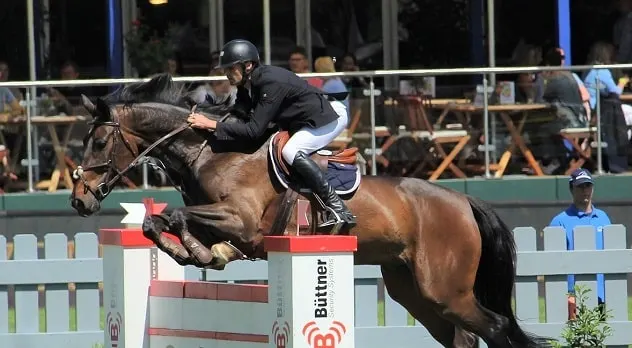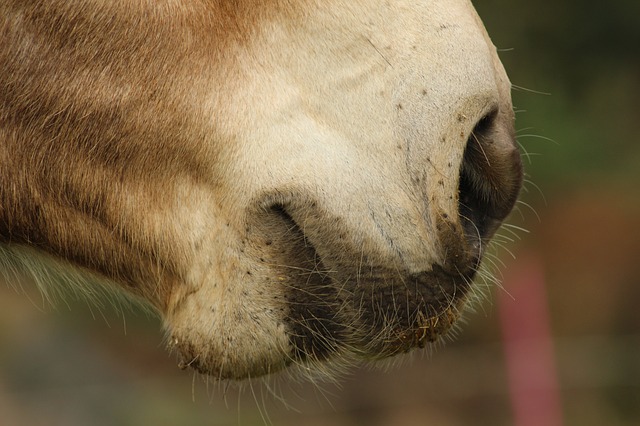On November 23, 2020, the FEI (International Federation for Equestrian Sports) passed a new rule that bans the removal of a horse’s whiskers in all international competitions.
The rule will become part of veterinary regulations in 2021, covering sport horses in all disciplines that compete internationally.
From July next year and on, any horse that has had their sensory hairs removed, unless for veterinary purposes, will be disqualified from competing in FEI competitions. This includes whiskers on the muzzles and eyes.
It does not include hairs inside the ears, as the FEI veterinary committee deems they are not sensory. The vote was passed unanimously at the federation’s general assembly.
The wording for the rule states that horses won’t be allowed to compete “if the horse’s sensory hairs have been clipped and/or shaven or in any other way removed unless individual sensory hairs have been removed by a veterinarian to prevent pain or discomfort for the horse.”
In addition, it is added that “Areas of hair that must be clipped, shaven or removed to allow veterinary treatment are exempt from this rule. As of 1 July 2021, sanction 39 in annex VI will be applicable.”
Current Horse Whisker Bans
Germany, Switzerland and France are among the countries that currently have some form of ban on whisker and/or hair removal to a certain degree.

In these nations, the rules have been passed as either animal welfare or equestrian federation rules.
“Clipping or shaving of sensory hairs is forbidden in Germany as well, therefore this addition is very welcome. This rule should, like in Germany, also apply to the hair inside the horse’s ears, which is part of an organ as well and has a protective function. Clipping the hair that is protruding the ear conch is permitted,” said the German Federation.
USEF Concerns on the Horse Whisker Ban
The USEF (United States Equestrian Federation) raised concerns about the enforcement of the new rule prior to the vote. They have voiced their concerns over the matter of the subject.
Prior to the vote on the rule, they submitted the following comment, “…there is still a great deal of subjectivity which could lead to irregular enforcement at different competitions.
Since clipping the sensory hairs results in disqualification, is it to be understood that ANY trimming or shortening of these hairs would cause disqualification? Clipped “at all” or clipped down to skin level?
It should be considered that when sensory hairs around the eye are left at full natural length, they can become tangled or trapped in the blinkers (blinders) of the driving bridle and potentially cause discomfort. Is there any consideration for whether this has been done at the Event vs away from the Event?”
The USEF asked for public input to be gathered and a review by a veterinary committee before the passing of the rule. However, despite their requests, the proposal stood and was voted in unanimously.
What Does a Horse’s Whiskers Do?
For horses, whiskers act as a sensory awareness system. Also known as vibrissae, these special tactile hairs help horses sense their surroundings.
Whiskers help aid horses with determining depth perception and gathering information on their environment. Horses use their vibrissae to determine a safe distance from unfamiliar objects. In addition, they can help assist horses in detecting unfamiliar or inedible items found in their food.

Eye whiskers are thought to help horses from getting eye injuries, as they work to help a horse automatically blink, which can prevent debris from entering the eye. However, there is no direct scientific proof on how or to what degree whiskers inform horses of their surroundings.
Dutch veterinarian Machteld Van Dierendonck did a pilot study on the function of horse whiskers and the effects of shaving them, but there were no conclusive results.
Should You Trim a Horse’s Whiskers?
There are two main reasons people trim horse whiskers: for veterinarian purposes and for appearance reasons.
In the United States, many disciplines will clip whiskers for showing to create a clean appearance.
Depending on the discipline you ride, trimming whiskers, specifically on the muzzle, maybe a common practice during show season.
When it comes to driving horses, some may trim eye whiskers to avoid them interfering with blinders and potentially causing discomfort.
In other cases, people may trim them to apply ointments to wounds, clean stitches, or remove ticks or burrs.
Some professionals believe that domesticated horses do not have as strong of a need to use whiskers as wild horses do. Many people in the equine world have varying opinions on whether whiskers should be trimmed or not.
Though horses can get on fine without whiskers, many veterinarians agree that it is best to leave them on horses when not showing.
Some, on the other hand, think that whiskers should always be kept and not clipped for show purposes.

While trimming or clipping whiskers on horses isn’t actually harmful, it does limit their ability to use them as nature intended. As there are no nerves in the whiskers themselves, it does not hurt the horse to trim or shave them.
Many experts encourage leaving whiskers on horses because of the benefits they have. At times, whiskers may act as a “third eye” for horses, as they allow them to sense food, danger, and their environment, especially when it is dark out.
However, many people trim whiskers with their horses experiencing no problems. Others believe that trimming whiskers is unnecessary as some horses may not adapt easily to getting their whiskers clipped.
Frequently Asked Questions Is the Hair Under a Horse’s Jawline Considered Whiskers?
Though horses may grow long hair under their jawline, especially in winter, this hair is not whiskers. Whiskers are stiffer and thicker than other hair. Horses have whiskers on their muzzles and around their eyes.
Why Do Foals Have Such Long Whiskers?
Foals often have much longer whiskers than adult horses. It is believed that the reason foals have such long whiskers is to help them find their mother’s teat to nurse. Whiskers are actually the first hairs to form during embryonic development.
How Does a Horse’s Whiskers Work?
Though whiskers themselves do not have nerves, the follicles they grow from are innervated. Signals from the whiskers are sent to a specific region of the brain where they are interpreted. This then helps the horse determine their surroundings based off their whiskers.
Source: https://horseyhooves.com





